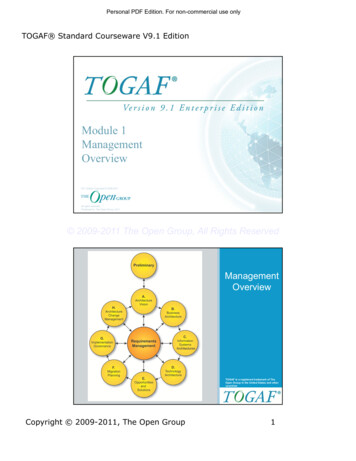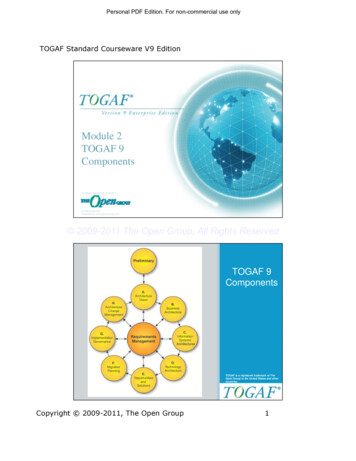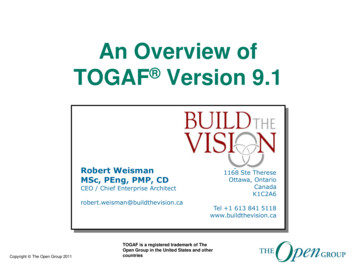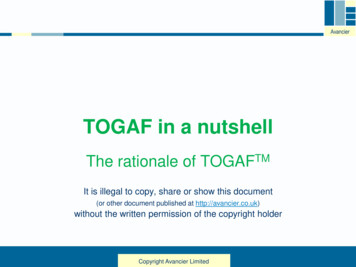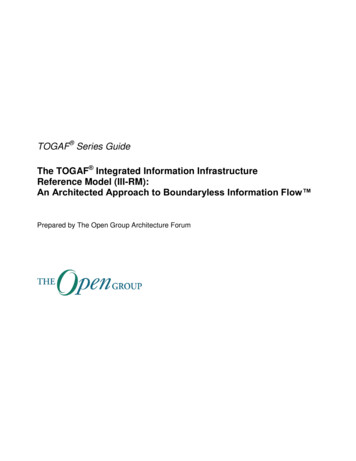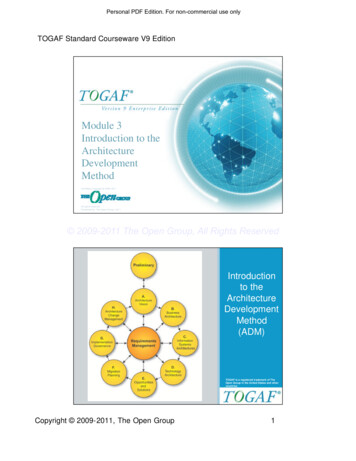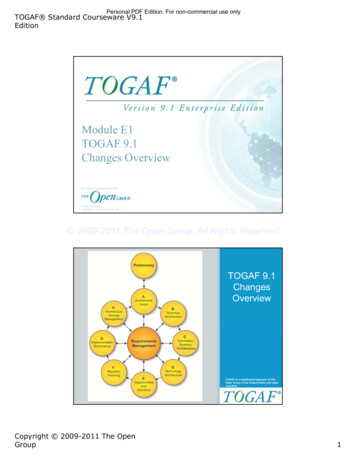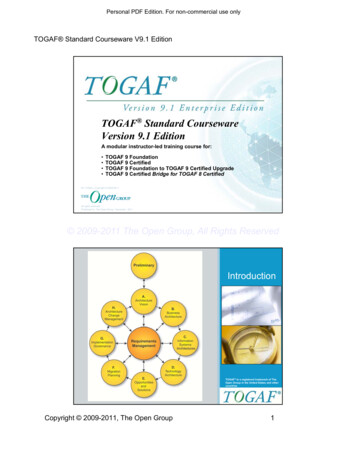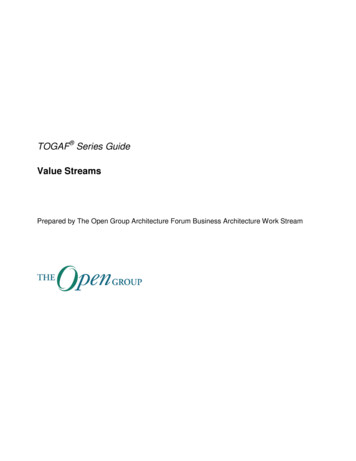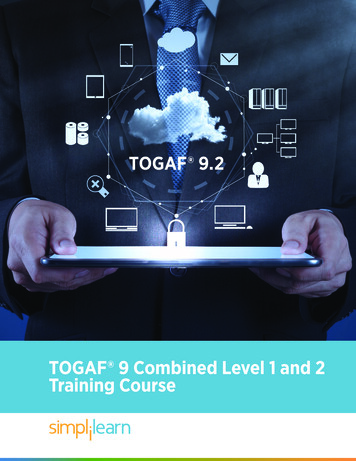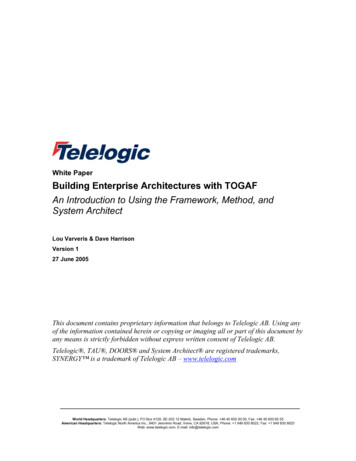
Transcription
White PaperBuilding Enterprise Architectures with TOGAFAn Introduction to Using the Framework, Method, andSystem ArchitectLou Varveris & Dave HarrisonVersion 127 June 2005This document contains proprietary information that belongs to Telelogic AB. Using anyof the information contained herein or copying or imaging all or part of this document byany means is strictly forbidden without express written consent of Telelogic AB.Telelogic , TAU , DOORS and System Architect are registered trademarks,SYNERGY is a trademark of Telelogic AB – www.telelogic.comWorld Headquarters: Telelogic AB (publ.), PO Box 4128, SE-203 12 Malmö, Sweden, Phone: 46 40 650 00 00, Fax: 46 40 650 65 55American Headquarters: Telelogic North America Inc., 9401 Jeronimo Road, Irvine, CA 92618, USA, Phone: 1 949 830 8022, Fax: 1 949 830 8023Web: www.telelogic.com, E-mail: info@telelogic.com
White PaperBuilding Enterprise Architectures with TOGAFTable of ContentsOverview. 3Introduction. 4History and Origin .4What Is Enterprise Architecture and Why Are People Doing It?. 4Obstacles to Enterprise Architecture . 5Enablers of Enterprise Architecture . 5What TOGAF Is and Why Companies Are Now Starting to Use It . 6How System Architect Enables TOGAF . 6TOGAF . 8The Enterprise Continuum .10The Architecture Continuum .11The Solutions Continuum.12The Architecture Development Method (ADM). 13Preliminary Framework and Principles . 14Stage A – Architecture Vision .15Request for Architecture Work. 16Stage B – Business Architecture. 17Methods and Notations to Choose. 18Creating Architecture Building Blocks (ABBs) . 22Stage C – Information Systems Architectures . 24Data Architecture .24Application Architecture .25Stage D – Technology Architecture . 26Stage E – Opportunities and Solutions . 28Stage F – Migration Planning.29Stage G – Implementation Governance. 30Stage H – Architecture Change Management . 30At the Center of It All – Requirements Management . 31Conclusion . 33TOGAF: Key to a Competitive Advantage . 33About Telelogic.352 of 35World Headquarters: Telelogic AB (publ.), PO Box 4128, SE-203 12 Malmö, Sweden, Phone: 46 40 650 00 00, Fax: 46 40 650 65 55American Headquarters: Telelogic North America Inc., 9401 Jeronimo Road, Irvine, CA 92618, USA, Phone: 1 949 830 8022, Fax: 1 949 830 8023Web: www.telelogic.com, E-mail: info@telelogic.com
White PaperBuilding Enterprise Architectures with TOGAFOverviewEnterprise architecture is the capture of all important information andbehavior that goes on in an organization -- the who, what, why, when,where, and how of the business. An enterprise architecture providesimportant value adds to an organization, enabling high-level managementto strategize more effectively, with a knowledge of cause-effectrelationships; business managers to oversee business processes andnetwork infrastructures with a clear understanding of the impact ofchanges; and policies and procedures to be communicated toall employees so that everyone can be on the same page. In short, itenables you to run an effective, efficient organization. !The Open Group Architecture Framework (TOGAF) is an importantenabler of enterprise architecture. TOGAF consists of a framework forcategorizing what you need to capture about the enterprise and a definitiveand proven step-by-step method, called the Architecture DevelopmentMethod (ADM), for developing, implementing, and maintaining theenterprise architecture.Telelogic System Architect is an important enabler of TOGAF and enterprise architectures. It is a repository-based modeling tool that enablesyou to capture all of the information that TOGAF prescribes, and disseminate that information to a wide audience through automatic reportgeneration and publishing of the architecture to the Web.This paper introduces you to TOGAF and the ADM, and describeshow System Architect is used with TOGAF to build and deploy anenterprise architecture.3 of 35World Headquarters: Telelogic AB (publ.), PO Box 4128, SE-203 12 Malmö, Sweden, Phone: 46 40 650 00 00, Fax: 46 40 650 65 55American Headquarters: Telelogic North America Inc., 9401 Jeronimo Road, Irvine, CA 92618, USA, Phone: 1 949 830 8022, Fax: 1 949 830 8023Web: www.telelogic.com, E-mail: info@telelogic.com
White PaperBuilding Enterprise Architectures with TOGAFIntroductionThe Open Group Architecture Framework (TOGAF) is quickly emergingas one of the most widely accepted paradigms for developing an enterprisearchitecture. Created by The Open Group (www.theopengroup.org),TOGAF is not just a framework for categorizing what you need to captureabout the enterprise, but also provides an Architecture DevelopmentMethod (ADM) for developing, implementing, and maintaining theenterprise architecture. This method plays along with many of theindustry’s most popular techniques and notations, such as business processmodeling with the Business Process Modeling Notation (BPMN), theUnified Modeling Language (UML), relational data modeling, IDEF(Integrated Computer-Aided Manufacturing (ICAM) DEFinition), andeven the techniques of the Department of Defense ArchitectureFramework (DoDAF).TOGAF is an open framework, the result of continuous contributions froma large number of architecture practitioners in The Open Group’sArchitecture Forum. The Open Group freely disseminates the TOGAFspecification and all related documentation on its Web site, and encouragesthe use of it by any organization embarking on enterprise architecture.TOGAF is highly customizable, enabling companies to tailor it to theirparticular challenges.There are two main components to TOGAF, represented by two differentgraphics familiar to TOGAF practitioners. The first is the TOGAFframework itself (pictured to the left in Figure 1), whose progression ofcircles illustrate the stages of its Architecture Development Method. Thesecond is the Enterprise Continuum (pictured to the right in Figure 1). TheEnterprise Continuum describes how the developing architecture iscomponentized into building blocks that are built upon, from the general(foundation) to ones specific to your organization.History and OriginTOGAF originated as the Technical Architecture for InformationManagement (TAFIM) in the US Department of Defense. The frameworkwas adopted by the Open Group in the mid-1990s, at the US DoD’surging. The first TOGAF specification was introduced in 1995, and thelatest version, TOGAF 8 (the Enterprise Edition), was released early in2004. TOGAF 9 is scheduled for release in December 2004.What Is Enterprise Architecture and Why Are People Doing It?Enterprise architecture is the capture of all behavior that goes on in anorganization, the data that is processed, who does what, where everythingis, and why everything is done. In a sentence, the who, what, why, when,4 of 35World Headquarters: Telelogic AB (publ.), PO Box 4128, SE-203 12 Malmö, Sweden, Phone: 46 40 650 00 00, Fax: 46 40 650 65 55American Headquarters: Telelogic North America Inc., 9401 Jeronimo Road, Irvine, CA 92618, USA, Phone: 1 949 830 8022, Fax: 1 949 830 8023Web: www.telelogic.com, E-mail: info@telelogic.com
White PaperBuilding Enterprise Architectures with TOGAFwhere, and how of the business, at every perspective, from high-levelcorporate goals to the code of low-level programs that implement businessprocesses to achieve those goals. Part of an effective enterprisearchitecture is communicating it to all necessary parties in an organization.With an enterprise architecture in place and effectively communicated,companies can realize a multitude of benefits. High-level management canstrategize more effectively, with a better understanding of the outcomeand ancillary effects of decisions that they make. Business managers canmanage business process and network infrastructure with a clearunderstanding of the impact of changes. The enterprise architecturepresents all stakeholders in an organization with a view of the information,processes, and related knowledge that they require to undertake their taskseffectively.In addition, new legislation such as Sarbanes-Oxley and the OFRlegislation that comes into force in January 2005 have made manyorganizations look at enterprise architecture as an almost mandatoryinvestment of time and resources, to help them effectively deal with thenew regulations.Obstacles to Enterprise ArchitectureThe need for an enterprise architecture has been around for a long time,but several obstacles prevented many organizations from undertaking itsuccessfully:!There was a lack of standard tools for capturing, developing andmanaging models.!Once modeled, it was difficult to maintain the information.!It was difficult to disseminate the information – everyone in theorganization needed a copy of the modeling tool.!There was a lack of a standard notation and consistent vocabularyfor enterprise architecture.!The ROI of a successful EA implementation was difficult tocalculate.Enablers of Enterprise ArchitectureIn recent years, new technologies have arrived to help make enterprisearchitecture achievable:!Corporate Intranets and the Internet offer a medium to disseminateinformation to everyone in the organization.!A new generation of enterprise architecture modeling tools hasarrived, capable of:5 of 35World Headquarters: Telelogic AB (publ.), PO Box 4128, SE-203 12 Malmö, Sweden, Phone: 46 40 650 00 00, Fax: 46 40 650 65 55American Headquarters: Telelogic North America Inc., 9401 Jeronimo Road, Irvine, CA 92618, USA, Phone: 1 949 830 8022, Fax: 1 949 830 8023Web: www.telelogic.com, E-mail: info@telelogic.com
White PaperBuilding Enterprise Architectures with TOGAFo supporting a broad spectrum of modeling notation;o providing a scalable and flexible underlying repository capableof storing and integrating models across all architecturedomains; ando offering sophisticated reporting and publication facilities.The final obstacle to overcome is the lack of a standard notation andmethod for developing and maintaining an enterprise architecture. Andthat is where TOGAF comes in.What TOGAF Is and Why Companies Are Now Starting to Use ItWhat makes TOGAF popular is that it contains a definitive and provenstep-by-step method for developing and maintaining an enterprisearchitecture. It covers the four principal architecture domains of business,information systems (application and data) and technology infrastructure,and focuses strongly on the need for architecture to support businessobjectives and requirements. It also takes into account establishing thegoals and objectives of the enterprise architecture effort itself, guidingusers on determining how much of the enterprise you need to model to getsignificant gains and the realities of getting buy-in from throughout theorganization.With TOGAF you are gaining the benefit of years of research and workperformed by originally by the US DoD, and in subsequent years by alarge group of the world’s leading enterprise architects in all industrysectors, and it is all open, customizable, and free.How Telelogic System Architect Enables TOGAFTelelogic System Architect is an important enabler of TOGAF. It is arepository-based modeling tool that enables you to capture all of the information that TOGAF prescribes to capture about your enterprise architecture,and disseminate that information to a wide audience through automaticreport generation and publishing of the information to the Web.True to the nature of TOGAF, System Architect does not limit you to anarrow set of modeling notations to choose from to build your enterprisearchitecture. It provides an extensive suite of diagram types, supporting allof the notations and methodologies suggested by TOGAF. This includesbusiness modeling, UML, relational data modeling, network diagramming,IDEF, DoDAF, and other techniques. All of the information that youcapture using the various techniques is integrated in the System Architectrepository. This integration of information is important. It enables you torealize an important byproduct of enterprise architecture – traceability ofinformation, enabling cause-effect analysis from the highest-level6 of 35World Headquarters: Telelogic AB (publ.), PO Box 4128, SE-203 12 Malmö, Sweden, Phone: 46 40 650 00 00, Fax: 46 40 650 65 55American Headquarters: Telelogic North America Inc., 9401 Jeronimo Road, Irvine, CA 92618, USA, Phone: 1 949 830 8022, Fax: 1 949 830 8023Web: www.telelogic.com, E-mail: info@telelogic.com
White PaperBuilding Enterprise Architectures with TOGAFoverview of the organization down to lowest-level technology designviews.System Architect’s repository can also hold requirements and ancillarydocuments, or references to external documents. Your entire enterprisearchitecture can be captured and maintained in the repository. Automaticreporting and Web publishing capabilities enable you to disseminate theenterprise architecture information to a wide audience.In addition to all of these natural capabilities of the tool, System Architectprovides specific support for TOGAF, which includes definition types,diagram types, cross-reference matrices, and automatic Word reports thatcapture information specified by TOGAF, and automatically generateTOGAF work products. Sections are provided in this white paper thatillustrate how System Architect provides direct support for TOGAF.7 of 35World Headquarters: Telelogic AB (publ.), PO Box 4128, SE-203 12 Malmö, Sweden, Phone: 46 40 650 00 00, Fax: 46 40 650 65 55American Headquarters: Telelogic North America Inc., 9401 Jeronimo Road, Irvine, CA 92618, USA, Phone: 1 949 830 8022, Fax: 1 949 830 8023Web: www.telelogic.com, E-mail: info@telelogic.com
White PaperBuilding Enterprise Architectures with TOGAFTOGAFTOGAF is a framework and a method for performing enterprisearchitecture. This makes it different from something like the ZachmanFramework, which is a framework that is concerned only with content andnot a method for building enterprise architectures. The term framework iswidely used in the industry today to mean different things. The definitionof framework as used by Zachman or TOGAF is that it is a tool forthinking about and categorizing the information that needs to be capturedabout an organization, to understand how everything works and to enablethe building of information systems that efficiently support the business.This is starkly different than frameworks of pre-built components such asthe .NET framework.But even when defined as a tool for thinking about what information youneed to capture, the term framework is a bit of a misnomer for TOGAF.As we mentioned, TOGAF does prescribe a method – the ArchitectureDevelopment Method (ADM) to be precise.As shown in Figure 1, TOGAF has two main components, the ADM(shown on the left side of Figure 1) and the Enterprise Continuum (rightside of Figure 1). The ADM is visually distinct from the Zachmanrectangular grid of cells; the TOGAF ADM graphic is dynamic – a set ofcircles representing the progression through the phases of the ADM andthe architecture models used and created during the phases of enterprisearchitecture development.The ADM is a detailed, step-by-step method on how to build, maintainand implement an enterprise architecture. These phases are navigatediteratively in a cycle. The circles represent the major phases of buildingand maintaining the enterprise architecture using the ADM.8 of 35World Headquarters: Telelogic AB (publ.), PO Box 4128, SE-203 12 Malmö, Sweden, Phone: 46 40 650 00 00, Fax: 46 40 650 65 55American Headquarters: Telelogic North America Inc., 9401 Jeronimo Road, Irvine, CA 92618, USA, Phone: 1 949 830 8022, Fax: 1 949 830 8023Web: www.telelogic.com, E-mail: info@telelogic.com
White PaperBuilding Enterprise Architectures with TOGAFFigure 1. TOGAF Enterprise consists of the Architecture Development Method (ADM) (pictured left) and theEnterprise Continuum (right). Source: The Open Group (www.theopengroup.org).9 of 35World Headquarters: Telelogic AB (publ.), PO Box 4128, SE-203 12 Malmö, Sweden, Phone: 46 40 650 00 00, Fax: 46 40 650 65 55American Headquarters: Telelogic North America Inc., 9401 Jeronimo Road, Irvine, CA 92618, USA, Phone: 1 949 830 8022, Fax: 1 949 830 8023Web: www.telelogic.com, E-mail: info@telelogic.com
White PaperBuilding Enterprise Architectures with TOGAFThe Enterprise ContinuumWhile the ADM specifies a process for building an enterprise architecture,the Enterprise Continuum is a resource and philosophy for developing anenterprise architecture through reusable building blocks.TOGAF’s Enterprise Continuum (Figure 2) specifies a progression fordeveloping architectures and solutions using architecture building blocks(ABBs) and solution building blocks (SBBs), in a continuous, iterativefashion. A building block is simply a grouping of functionality defined tomeet business needs. An architecture building block is described with ageneral level of detail. For example, an architecture building block mightbe specified as an on-line database and the application used to access it.Later on in the ADM, you replace ABBs with SBBs, which reflect realproducts or specific custom developments.Looking at the Enterprise Continuum pictured in Figure 2, you can seethat it is composed of the Architecture and Solution Continuums. At thetop of the graphic you can see the Architecture Continuum, whichprovides guidance, direction, and support to use the Solutions Continuum(below it) to build your particular technology architecture.You build your architecture by navigating the two continuums, from left toright, top to bottom, so that you are specifying architecture building blocksat each stage, and then the solution building blocks that implement them,and continuing right-ward, building upon your solution and addingincreasing detail. In the end, the Solutions Continuum defines thesolutions that deliver your architecture, which include either off-the-shelfsolutions and/or your organization’s own custom solutions.As we will discuss later in this white paper, it is the TOGAF ADM thatguides you through the left-to-right progression from the generalarchitectures and solutions (on the left), to organization-specific ones (onthe right).10 of 35World Headquarters: Telelogic AB (publ.), PO Box 4128, SE-203 12 Malmö, Sweden, Phone: 46 40 650 00 00, Fax: 46 40 650 65 55American Headquarters: Telelogic North America Inc., 9401 Jeronimo Road, Irvine, CA 92618, USA, Phone: 1 949 830 8022, Fax: 1 949 830 8023Web: www.telelogic.com, E-mail: info@telelogic.com
White PaperBuilding Enterprise Architectures with TOGAFFigure 2. TOGAF Enterprise Continuum, showing the progression that leads to the increasing refinement of theorganization-specific architecture. Source: The Open Group (www.theopengroup.org).The Architecture ContinuumThe Architecture Continuum defines the components that specify thearchitecture of your organization. You start your architecture effort with aFoundation Architecture, then build upon this foundation using commonsystems architectures (for example, a generic security architecture), andindustry-specific architectures (for example, a Retail IndustryArchitecture), to reach the architecture specific to your organization (onthe right).During the preliminary stage of ADM, you establish how much of yourFoundation Architecture can be established from what is already in placein your organization. TOGAF provides a Foundation Architecture to helpyou get started, embodied in the Technical Reference Model (TRM) andStandards Information Base (SIB). The SIB is provided onwww.theopengroup.org. It provides you with a portal to an exhaustive listof standards that an architecture should mandate, and the availability in themarket place of products guaranteed to conform to those standards.Once your organization has been through its first TOGAF ADM iteration,your own Technology Architecture and solutions portfolio form part ofyour Foundation Architecture for the next cycle.!Foundation Architectures -- A Foundation Architecture is whatyou start with. It consists of architecture building blocks andcorresponding standards that support your complete computingenvironment. You may use TOGAF’s pre-supplied FoundationArchitecture, which consists of the Technical Reference Model andStandards Information Base. You then follow the steps of the11 of 35World Headquarters: Telelogic AB (publ.), PO Box 4128, SE-203 12 Malmö, Sweden, Phone: 46 40 650 00 00, Fax: 46 40 650 65 55American Headquarters: Telelogic North America Inc., 9401 Jeronimo Road, Irvine, CA 92618, USA, Phone: 1 949 830 8022, Fax: 1 949 830 8023Web: www.telelogic.com, E-mail: info@telelogic.com
White PaperBuilding Enterprise Architectures with TOGAFTOGAF ADM to get from that foundation architecture to onespecific to your organization.!Common Systems Architectures -- A Common SystemArchitecture is complete in terms of a particular problem domain,but incomplete in terms of the overall information systemfunctionality. Examples of Common Systems Architectures are aNetwork Architecture, a Security Architecture, and so forth.!Industry Architectures -- Industry Architectures include pre-built,off-the-shelf architectures that have been developed for particularvertical industries. These pre-built architectures often offer pre-builtdata models and processes. Examples are the ARTS Retail DataModel, the AKMA Insurance Data Frame, and the NHSIA PatientCare Process.The Solutions ContinuumThe Solutions Continuum defines the set of solutions that implement yourarchitecture. You build from left to right, in parallel with the ArchitectureContinuum, starting with a generic set of products and services that deliverthe Foundation Architecture, adding Systems and Industry solutions (forexample, a DBMS such as Oracle 8 and a CRM package application), tobuild the set of technology and business solutions specific to yourorganization.!Products and Services -- Products include hardware and softwarethat you may purchase. Services include training, consultingservices, and technical support. Services enable you to maximizeyour investment in products and help you to get everyone up andrunning in minimal time.!Systems Solutions -- A System Solution is an implementation of aCommon System Architecture comprising of a set of products andservices, which may be certified or branded.!Industry Solutions -- An Industry Solution is an implementation ofan Industry Architecture. Examples might be a particular CRMsystem, or Web-based product purchasing system.12 of 35World Headquarters: Telelogic AB (publ.), PO Box 4128, SE-203 12 Malmö, Sweden, Phone: 46 40 650 00 00, Fax: 46 40 650 65 55American Headquarters: Telelogic North America Inc., 9401 Jeronimo Road, Irvine, CA 92618, USA, Phone: 1 949 830 8022, Fax: 1 949 830 8023Web: www.telelogic.com, E-mail: info@telelogic.com
White PaperBuilding Enterprise Architectures with TOGAFThe Architecture Development Method (ADM)The ADM (Figure 1) forms the core of TOGAF. At the heart of ADM isrequirements management. The business, information systems, andtechnology architectures are always aligned with requirements and relatedbusiness goals, and the arrows indicate that this is continuous processthroughout the ADM stages.Figure 3. TOGAF Enterprise. Source: The Open Group (www.theopengroup.org).13 of 35World Headquarters: Telelogic AB (publ.), PO Box 4128, SE-203 12 Malmö, Sweden, Phone: 46 40 650 00 00, Fax: 46 40 650 65 55American Headquarters: Telelogic North America Inc., 9401 Jeronimo Road, Irvine, CA 92618, USA, Phone: 1 949 830 8022, Fax: 1 949 830 8023Web: www.telelogic.com, E-mail: info@telelogic.com
White PaperBuilding Enterprise Architectures with TOGAFPreliminary Framework and PrinciplesA part of the architecture effort not to be overlooked is the preliminarystage, during which the architecture vision and the scope of the enterprisearchitecture effort are established, and key questions about the architectureare answered – how much information will you capture, how will youmaintain it, how will it be used and what kind of management buy-in isneeded. In other words you specify the who, what, why, when, and whereof the architecture effort itself.“What” is the scope of the architecture effort. You need to understandfrom the outset how encompassing your architecture effort will be. Whenyou look at any organization, there is a lot to model. Off the top, youmight start with the business processes integral to the organization, theapplications and databases that those processes use, and the networkarchitecture that everything runs on. But there’s a lot more – from highestlevel goals and objectives of the company, to ancillary processes such as,for example, the techniques that the human resource department uses tofind new hires, down to the technical specifications and models for theproducts that the company develops. You need to understand from theoutset how much of this you intend to model.And you must specify “who” is going to model it. TOGAF considers thisthe “architecture footprint” for the organization – the people responsiblefor performing the architecture work, where they are located, and theirresponsibilities. Will there be a core architecture group that does all themodeling? Will individual department managers be tasked to model theirdepartment’s processes? Who is responsible for product specifications?You determine “how” you will develop the enterprise architecture,specifying the framework and method that you will use to captureinformation. You may use the TOGAF framework and method, or tailor itto suit your needs, or use it in conjunction with other methods. During thepreliminary phase you also specify deliverable dates of the architectureeffort – the “when.”And then there is the matter of management buy-in. To support the "whyare you doing this” question, you need to establish the business principals,goals, and drivers of the organization. Showing how the architecture effortwill help you meet these goals helps you get management buy in.14 of 35World Headquarters: Telelogic AB (publ.), PO Box 4128, SE-203 12 Malmö, Sweden, Phone: 46 40 650 00 00, Fax: 46 40 650 65 55American Headquarters: Telelogic North America Inc., 9401 Jeronimo Road, Irvine, CA 92618, USA, Phone: 1 949 830 8022, Fax: 1 949 830 8023Web: www.telelogic.com, E-mail: info@telelogic.com
White PaperBuilding Enterprise Architectures with TOGAFStage A – Architecture VisionIn stage A you continue the work begun in the preliminary phase, and addmore substance to it. You evaluate any architecture that your organizationalready has in place and consider how it may be re-used, for example thehardware systems that have been documented, and the relational databasesthat have been designed. How is their entry point into enterprisearchitecture different than other companies?Each stage of TOGAF has inputs and outputs. An important input to StageA is a Request for Architecture Work document, which gets transformedduring the stage into an important output – the Statement of ArchitectureWork, which de
Title: Building Enterprise Architectures with TOGAF Author: Lou Varveris & Dave Harrison Subject: K
